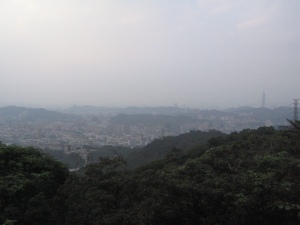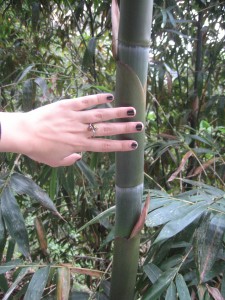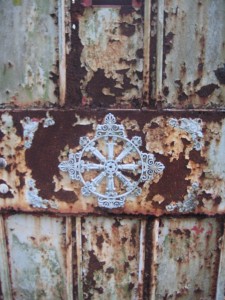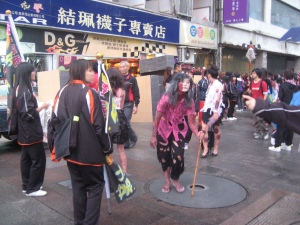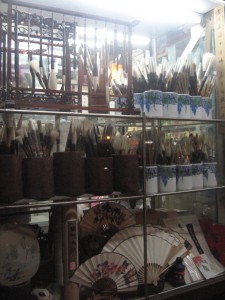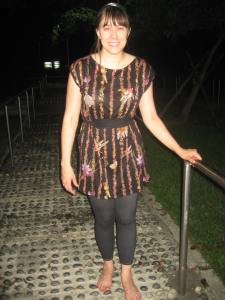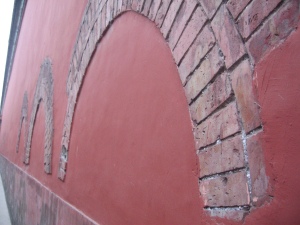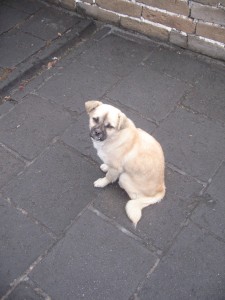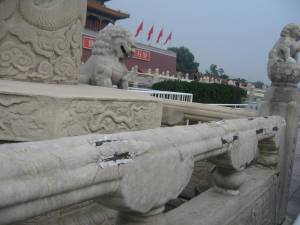One of my main goals for my time in Taipei was to bravely face and conquer stinky tofu. I was determined to sample the stuff (a vegan version without the fish sauce, of course). People told me stinky tofu smells like rotten eggs, rubbish, or sewage. I was told you either love and hate it, and you can smell stinky tofu stands for at least a one block radius. You can tell who loves it and who hates it, because you’ll see some people running towards the noxious odour and others fleeing. People warned me long before I set foot in Taiwan, but I didn’t believe the odour could be so bad until the first time I smelled it. My first time was when I was walking through a night market near where I was staying, searching for the vegetarian food stall. I found it right next to the stinky tofu stall. One whiff of the odour, and I lost my appetite. I nearly vomited into my bag of fresh-cut pineapple, too. I didn’t eat dinner that night.
Stinky tofu experience aside, I have to admit, I began to feel a bit spoiled food-wise while I was in Taipei. Each morning, I’d wake up mid-morning and, after getting ready, go out to find lunch. Usually I’d walk about five minutes in any direction and I’d find a vegetarian restaurant. If I didn’t like it, I’d walk another five minutes until I found another. Taipei has a population of 2.6 million and possesses 300 vegetarian restaurants, so they are very concentrated around the city, making veggie food easy to obtain (though you have to check what’s vegan). Plus, many of them are really cheap! I’d often eat lunch and dinner for around $1 or $2 per meal.
Taipei’s full of great, cheap food stalls and little restaurants that consist of an outdoor or semi-outdoor kitchen with a few tables next to it. Some are clean and some less so, but I never got ill. My favourite was across the street from the first hostel I stayed in and was completely vegan. I loved being able to see my food cooked fresh before my eyes; the owner even made her dumplings from scratch (other places used frozen dumplings or premade dumpling skin). I even came to love the ambiance–the napkins on the dispenser on the wall, the lack of drinks (even water), the fact that you had to go into the kitchen and find the owner/cook to pay and you never got a receipt. She made some of the most delicious food I had in Taipei and it cost under $2. My favourites were her mahjiang mien (see below) and dumplings (below). Her food was as good as the $30, 10-course meal I had, though it lacked the ambiance and presentation.

Hot pot containing every vegetable imaginable

One of my favourite dishes, mahjiang mien (sesame noodles), about $1.50 or £1

10 handmade dumplings, $1.50/£1
I also splurged on a meal at the fanciest vegetarian restaurant in Taipei, Yu Shan Ge, where many vegetarian celebrities eat. I bought the second cheapest option on the menu, $30 for 10 courses (I think the cheapest was $25 for 5 courses), which they veganised for me. (Incidentally, a review I’d read online led me to believe the staff spoke English, but the ones I spoke to didn’t–so you’d need some Chinese to comunicate your desire for a vegan meal.) The meal was excellent, and the presentation incredible, but I felt slightly uncomfortable because it was just so fancy and I felt a little too spoiled with two waiters for the five people in my room/section of the restaurant. Plus, the doorman kept hitting on me, which I’m pretty sure wasn’t a part of his job description. What follows below is a lot of pictures, from every course, so if you’re bored by the food pictures so far, you might want to skip this.

The place setting of the table at Yu Shan Ge. They even arranged the napkins to look pretty. The silver/blue napkin you see in the foreground is actually a bib they put on me!

Not thrilled with my silver bib
The meal began with them bringing me a bowl of rosewater in which to wash my hands. They also brought me tea throughout the meal. It was absolutely amazing, some of the best tea I’d ever tasted, so at the end I asked them what kind of tea it was, hoping I could buy some before leaving Taipei. They told me it was their own blend of sweet potato, licorice root, and ginseng. Guess it’s a once in a lifetime experience unless I figure out how to make that myself!

Handwashing bowl
I’m not sure, but based on reviews I’d read before, I believe the first course was a mock shark fin soup. I’ve no idea how authentic it tasted, but it was really good, with a great mouthfeel. It seemed to coat the inside of your mouth, but in a good way, not a gross way.

Course #1: Shark fin soup?
The second course consisted of a bunch of adorable things. This course was kind of tasteless, but it was SO CUTE!

Course #2: tiny cute things on a plank.
The third course was a squash stew. It was creamy and delicious, and nicely presented with a flower and a sprinkling of black sesame seeds on a wooden plank.

Course #3: Squash stew.
The fourth course was roasted aubergine. I’m usually not a fan, but this was really good. It was so soft (I guess it had been roasted for such a long time) it fell apart when I cut into it.

Course #4: Roasted aubergine/eggplant.
The fifth course (if it can be called a course) was a palate cleanser, I guess. The little cup contained a vinegar-y drink. It was presented on a bed of pebbles, with a larger rock, some branches, and a flower. What elaborate presentation for a tiny cup of just a few mLs of liquid!

Palate cleanser
Course #6 was the main course, a “steak” apparently made of mushrooms. It was elaborately presented with leaves and flowers to make it look like a plant. One review I’d read criticised the fact that it was doused in an Asian-style sauce that they thought contained Chinese 5 spice powder, when they thought it should have been accompanied by American-style steak flavouring. Well, I’ve never had a steak, in America or elsewhere, so I can’t comment on American steak sauce, but I’ll say that I really liked the sauce on this ‘steak’ and thought it was had a nice kick. Plus I liked that they utilised local spices for flavourings. I’m not usually a fan of faux meat but this was pretty good.

Main course: "steak"
The seventh course was a soup containing loads of different types of mushrooms. I’m not a huge fan of mushrooms, so I didn’t get that excited about the soup.

Course #7: Mushroom soup
The eighth course was fried rice. It was good but not excellent, and at that point I was starting to feel stuffed.
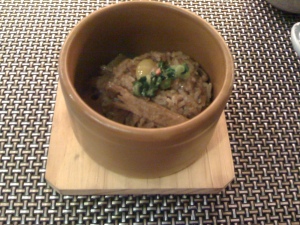
Course #8: fried rice
By the time the ninth course was due to arrive, I was starting to feel like my stomach was going to explode, and silently began hoping that no more food would appear. I’d been eating for two hours, and though the courses were small, it was too much! But the ninth course came out, and it turned out to be my favourite! I’m not sure what it was; it seemed to be a simple soup of shoots and a clear broth. The waiter instructed me to squeeze the lemon into it, and it gave the broth a delicious and delicate balance of flavours.

Course #9
Normally I would have been a bit disappointed with the dessert they gave me, a porridge with raisins and a side of fruit. But given how full of was, I was extremely relieved to have such a light dessert.

Course #10: Dessert
I left Yu Shan Ge full of good food–but a little too full–and with the doorman’s phone number in hand (ugh!)! I’m glad I had the experience. It’s not every day, after all, that I get waited on like that or that I start a meal by washing my hands in rosewater. It was a fun experience, and although it was pricey at $30, was much less expensive than a similar experience would cost in the US or the UK.


























